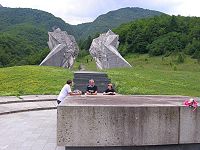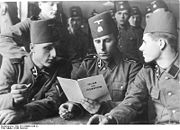.gif)
History of Bosnia and Herzegovina (1941–1945)
Encyclopedia

Kingdom of Yugoslavia
The Kingdom of Yugoslavia was a state stretching from the Western Balkans to Central Europe which existed during the often-tumultuous interwar era of 1918–1941...
was invaded by the Axis powers
Axis Powers
The Axis powers , also known as the Axis alliance, Axis nations, Axis countries, or just the Axis, was an alignment of great powers during the mid-20th century that fought World War II against the Allies. It began in 1936 with treaties of friendship between Germany and Italy and between Germany and...
during World War II
World War II
World War II, or the Second World War , was a global conflict lasting from 1939 to 1945, involving most of the world's nations—including all of the great powers—eventually forming two opposing military alliances: the Allies and the Axis...
, all of Bosnia was ceded to the newly-created Independent State of Croatia
Independent State of Croatia
The Independent State of Croatia was a World War II puppet state of Nazi Germany, established on a part of Axis-occupied Yugoslavia. The NDH was founded on 10 April 1941, after the invasion of Yugoslavia by the Axis powers. All of Bosnia and Herzegovina was annexed to NDH, together with some parts...
. Axis rule in Bosnia led to widespread persecution and mass-killings of native undesirables and anti-fascists. Many Serbs themselves took up arms and joined the Chetniks
Chetniks
Chetniks, or the Chetnik movement , were Serbian nationalist and royalist paramilitary organizations from the first half of the 20th century. The Chetniks were formed as a Serbian resistance against the Ottoman Empire in 1904, and participated in the Balkan Wars, World War I, and World War II...
; a Serb nationalist and royalist resistance movement that conducted ineffective guerrilla warfare
Guerrilla warfare
Guerrilla warfare is a form of irregular warfare and refers to conflicts in which a small group of combatants including, but not limited to, armed civilians use military tactics, such as ambushes, sabotage, raids, the element of surprise, and extraordinary mobility to harass a larger and...
against the occupying Nazi forces, only to collaborate with them later in the war against the communist partisans. The Chetniks were also known to persecute and murder non-Serbs and communist sympathizers. On October 12, 1941 a group of 108 notable Muslim citizens of Sarajevo
Sarajevo
Sarajevo |Bosnia]], surrounded by the Dinaric Alps and situated along the Miljacka River in the heart of Southeastern Europe and the Balkans....
signed the Resolution of Sarajevo Muslims
Resolution of Sarajevo Muslims
The Resolution of Sarajevo Muslims or Muslim Resolution of 1941 was one of the resolutions of Muslims from Bosnia and Herzegovina declared by 108 notable Muslim citizens of Sarajevo during the Second World War in Sarajevo on October 12, 1941...
by which they condemned the persecution of Serbs
World War II persecution of Serbs
The Serbian Genocide refers to the attempt in extermination made towards ethnic Serbs in 1939-1945 by predominantly ethnic Croat Fascists and Nazi occupational forces....
organized by Ustaše
Ustaše
The Ustaša - Croatian Revolutionary Movement was a Croatian fascist anti-Yugoslav separatist movement. The ideology of the movement was a blend of fascism, Nazism, and Croatian nationalism. The Ustaše supported the creation of a Greater Croatia that would span to the River Drina and to the border...
, made distinction between Muslims who participated in such persecutions and whole Muslim population, presented informations about the persecutions of Muslims by Serbs and requested security for all citizens of the country, regardless of their identity.
Starting in 1941, Yugoslav communists under the leadership of Josip Broz Tito
Josip Broz Tito
Marshal Josip Broz Tito – 4 May 1980) was a Yugoslav revolutionary and statesman. While his presidency has been criticized as authoritarian, Tito was a popular public figure both in Yugoslavia and abroad, viewed as a unifying symbol for the nations of the Yugoslav federation...
organized their own multi-ethnic resistance group, the partisans
Partisans (Yugoslavia)
The Yugoslav Partisans, or simply the Partisans were a Communist-led World War II anti-fascist resistance movement in Yugoslavia...
, who fought against both Axis and Chetnik forces. On 29 November 1943 the Anti-Fascist Council of National Liberation of Yugoslavia with Tito at its helm held a founding conference in Jajce
Jajce
Jajce is a city and municipality located in the central part of Bosnia and Herzegovina. It is part of the Central Bosnia Canton of the Federation of Bosnia and Herzegovina entity...
where Bosnia and Herzegovina was reestablished as a republic within the Yugoslavian federation in its Ottoman borders. Military success eventually prompted the Allies
Allies of World War II
The Allies of World War II were the countries that opposed the Axis powers during the Second World War . Former Axis states contributing to the Allied victory are not considered Allied states...
to support the Partisans, and the end of the war resulted in the establishment of the Socialist Federal Republic of Yugoslavia
Socialist Federal Republic of Yugoslavia
The Socialist Federal Republic of Yugoslavia was the Yugoslav state that existed from the abolition of the Yugoslav monarchy until it was dissolved in 1992 amid the Yugoslav Wars. It was a socialist state and a federation made up of six socialist republics: Bosnia and Herzegovina, Croatia,...
, with the constitution of 1946
Constitution of the Socialist Federal Republic of Yugoslavia
The Constitution of the Socialist Federal Republic of Yugoslavia was the supreme law of S.F.R. Yugoslavia and its predecessor, the Federal People's Republic of Yugoslavia .-Federal constitutions:...
officially making Bosnia and Herzegovina
Socialist Republic of Bosnia and Herzegovina
Socialist Republic of Bosnia and Herzegovina , known until 1963 under the name of People's Republic of Bosnia and Herzegovina, was a socialist state that was a constituent country of the former Socialist Federal Republic of Yugoslavia...
one of six constituent republics in the new state.
During the war, and following the massive deterioration of internal security under the incompetent Ustaše
Ustaše
The Ustaša - Croatian Revolutionary Movement was a Croatian fascist anti-Yugoslav separatist movement. The ideology of the movement was a blend of fascism, Nazism, and Croatian nationalism. The Ustaše supported the creation of a Greater Croatia that would span to the River Drina and to the border...
regime, the Nazis tried to create a quisling
Quisling
Quisling is a term used in reference to fascist and collaborationist political parties and military and paramilitary forces in occupied Allied countries which collaborated with Axis occupiers in World War II, as well as for their members and other collaborators.- Etymology :The term was coined by...
Waffen-SS
Waffen-SS
The Waffen-SS was a multi-ethnic and multi-national military force of the Third Reich. It constituted the armed wing of the Schutzstaffel or SS, an organ of the Nazi Party. The Waffen-SS saw action throughout World War II and grew from three regiments to over 38 divisions, and served alongside...
unit in Bosnia called the 13th Waffen Mountain Division of the SS Handschar (1st Croatian)
13th Waffen Mountain Division of the SS Handschar (1st Croatian)
The 13th Waffen Mountain Division of the SS Handschar was one of the thirty-eight divisions fielded as part of the Waffen-SS during World War II. Its recruits were composed of Muslim Bosniaks. The Handschar division was a mountain infantry formation, the equivalent of the German "Gebirgsjäger" ...
in February 1943. Imam Halim Malkoć was the only Muslim
Muslim
A Muslim, also spelled Moslem, is an adherent of Islam, a monotheistic, Abrahamic religion based on the Quran, which Muslims consider the verbatim word of God as revealed to prophet Muhammad. "Muslim" is the Arabic term for "submitter" .Muslims believe that God is one and incomparable...
to earn the German
Germany
Germany , officially the Federal Republic of Germany , is a federal parliamentary republic in Europe. The country consists of 16 states while the capital and largest city is Berlin. Germany covers an area of 357,021 km2 and has a largely temperate seasonal climate...
Iron Cross
Iron Cross
The Iron Cross is a cross symbol typically in black with a white or silver outline that originated after 1219 when the Kingdom of Jerusalem granted the Teutonic Order the right to combine the Teutonic Black Cross placed above a silver Cross of Jerusalem....
during World War II
World War II
World War II, or the Second World War , was a global conflict lasting from 1939 to 1945, involving most of the world's nations—including all of the great powers—eventually forming two opposing military alliances: the Allies and the Axis...
. The formation was not largely unsuccessful and many men deserted to the Communist partisans, but the concept served as very useful anti-Muslim propaganda after 1945.


